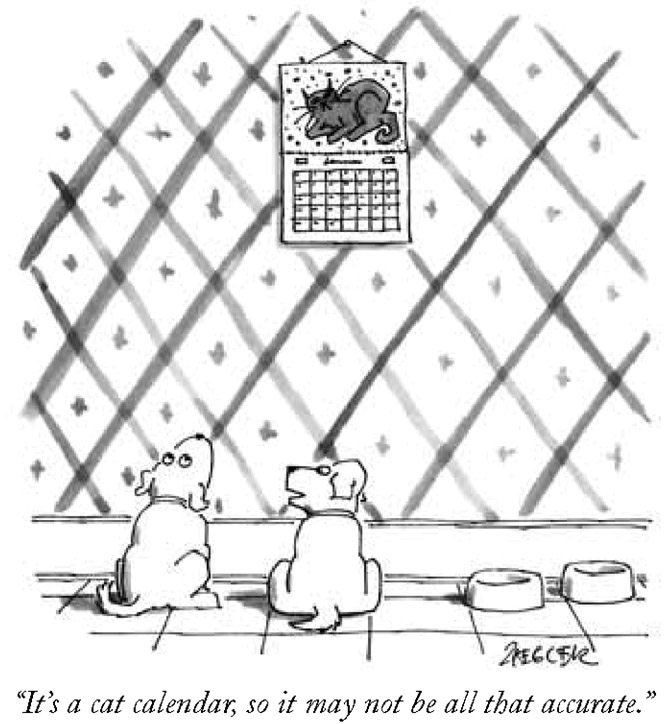

| The
Calendar (cartoon by Jack Ziegler, from the New Yorker, 1/30/1995) |
Whether we wake or we sleep, Whether we carol or weep, The Sun with his Planets in chime, Marketh the going of Time. - Edward Fitzgerald, Chronomoros |
The very regular motions of the sun, moon, and planets made astronomy play a central role in time keeping. Our current calendar has roots in Babylonian astronomy, and our division of the hour into 60 minutes and the minute into 60 seconds derives from the Babylonian base 60 number system. The basic astronomical divisions are the day, orbital period of the moon (strictly speaking the synodic period, over which it returns to the same relation to Earth and Sun) and the year. These divisions do not divide exactly into each other:
The synodic period of the moon is 29.53059 days
The year is 365.2422 days.
For this reason, setting up a lasting framework for keeping time was a major challenge.
The ancient Egyptians used a calendar with 12 months of 30 days, based on the synodic period of the moon. However, this left 5 days, a problem they corrected by adding them at the end of the year starting in about 4000 B.C. Still, they were off by 0.2422 days per year. They just let the months drift relative to the years, until in 1460 years the months had drifted an entire year's worth. Then they added an extra year.
Other societies in the ancient Near East used calendars with months that alternated between 29 and 30 days (coming closer to the lunar synodic period) and added a month about every third year to keep in synchronization with the year. In the Greek city states months were added haphazardly as needed and no consistent system was ever developed. The most sophisticated system of keeping the calendar synchronized with the motions of both the Sun and Moon was developed by the Babylonians (and others in Mesopotamia). It made use of the coincidence that 19 years is equal in length to 235 lunar synodic periods, to within about two hours. A calendar on this system was used from about 500 to 75 B.C.
The Romans made calendars extra difficult because they believed that even numbers were unlucky. Hence, with the exception of February at 28 days, their months were 29 or 31 days long. Because four months of 31 days, seven months of 29 days, and one month of 28 days added up to only 355 days, they had to add an extra month called Mercedonius of 22 or 23 days that was put into the cycle every second year. Still, their calendar drifted steadily out of synchronization. Julius Caesar, advised by the astronomer Sosigenes, ordered a sweeping reform in 45 B.C. One year was made 445 days to bring the calendar back in step with the seasons. The months were set to 30 or 31 days in length (July, named after Julius Caesar, naturally had to be 31 days), and to take care of the extra 0.2422 days, every fourth year was made 366 days.
This calendar was named the Julian calendar, after Julius Caesar. However, the Julian calendar is still 11 minutes longer than the actual solar year, and after a number of centuries, even 11 minutes adds up.
| The problem was well known among educated people, as shown by this quotation from Dante, but it took great authority to organize a correction. | "..ere from winter January advance To spring, through the hundredth part which ye neglect." -- Dante, Paradiso, Canto XXVII, 14th century |
By the 15th century, things were out of order by about a week. In 1545, the Council of Trent authorized Pope Paul III to reform the calendar once more. The immediate correction, advised by the Jesuit astronomer Father Clavius and ordered by Pope Gregory XIII, was that the day after Thursday, Oct. 4, 1582, was to be Friday, Oct. 15. To maintain long range synchronization, every fourth year is a leap year unless it is a century year like 1700 or 1800. However, century years that are divisible by 400 (e.g., 1600 and 2000) are retained as leap years. This rule eliminates three leap years in four centuries, making the calendar accurate to within about 30 seconds per year. This system is called the Gregorian Calendar.
The Gregorian Calendar was adopted by Catholic countries in 1582, but other areas waited, sometimes for centuries. For example, England switched only in 1752, and Russia in 1918.
(cartoon from The New Yorker)